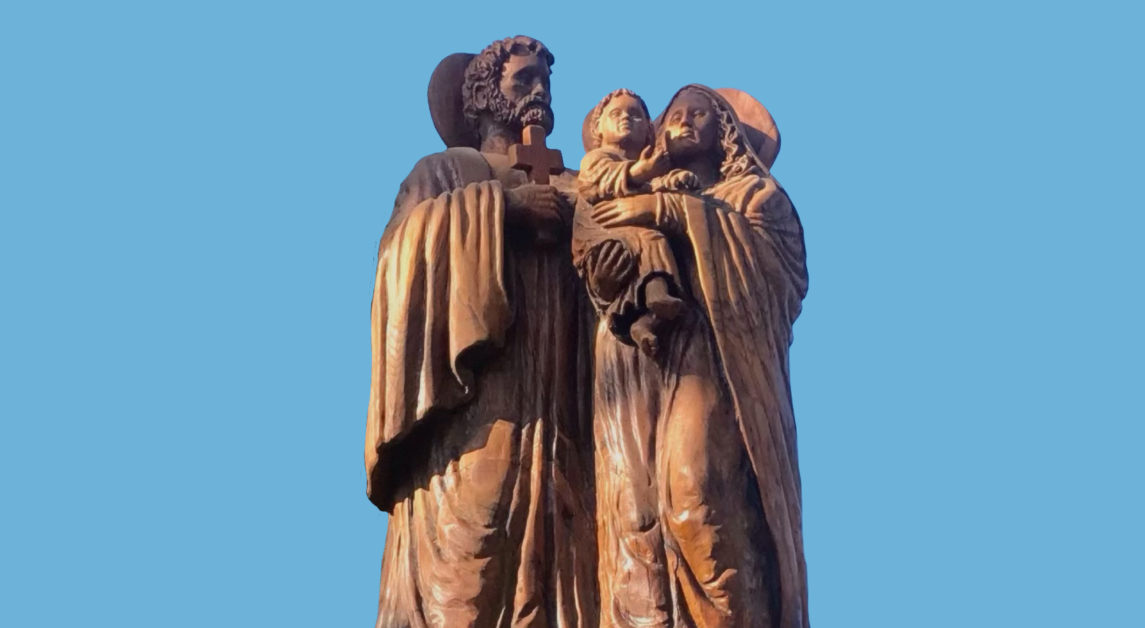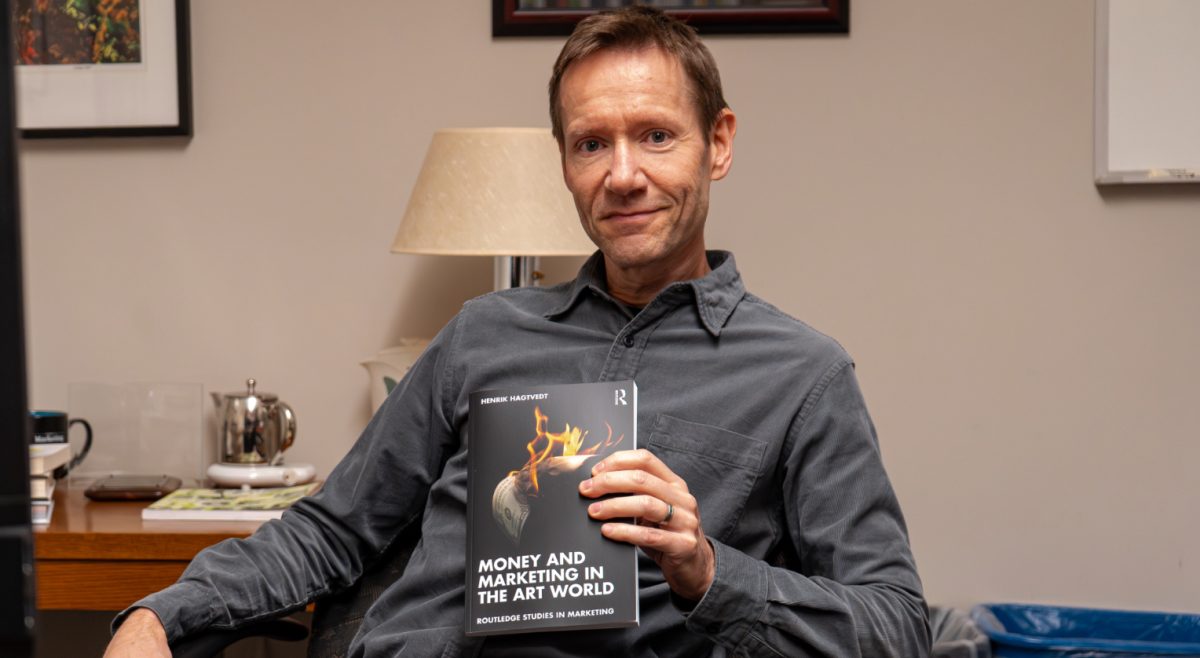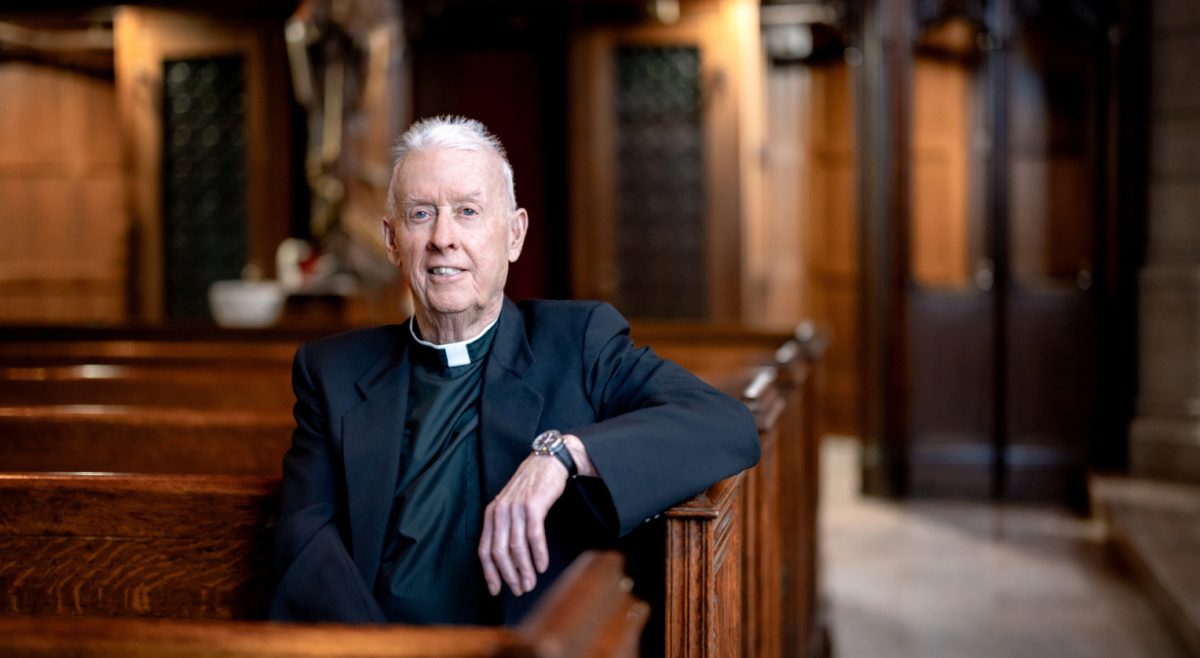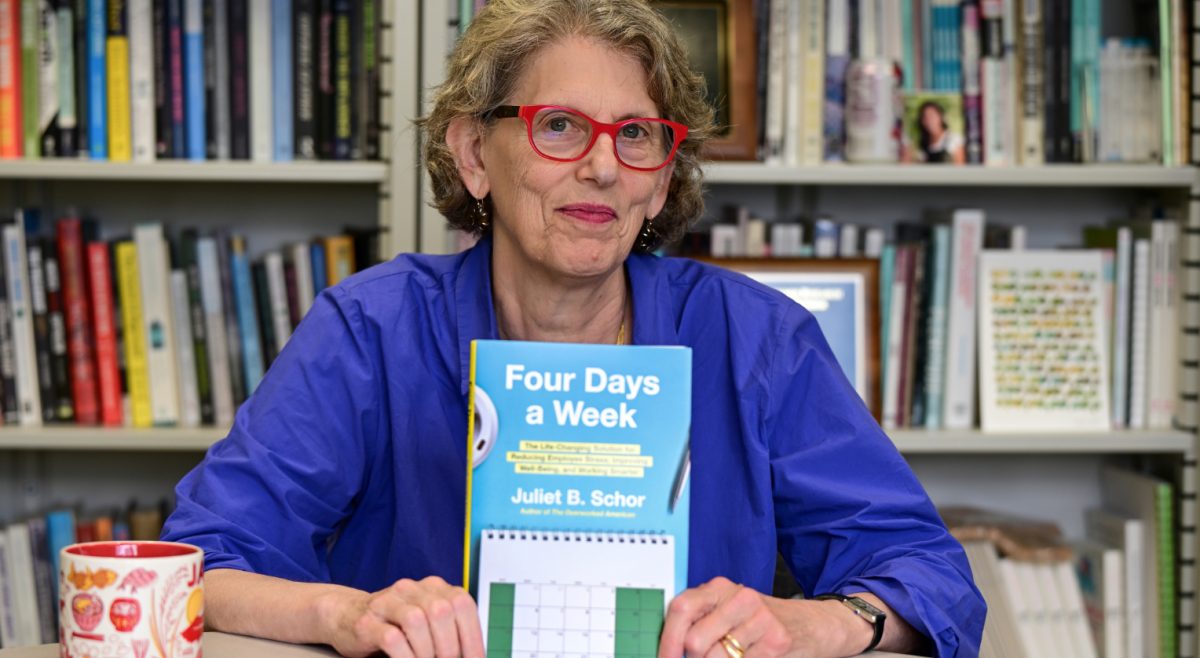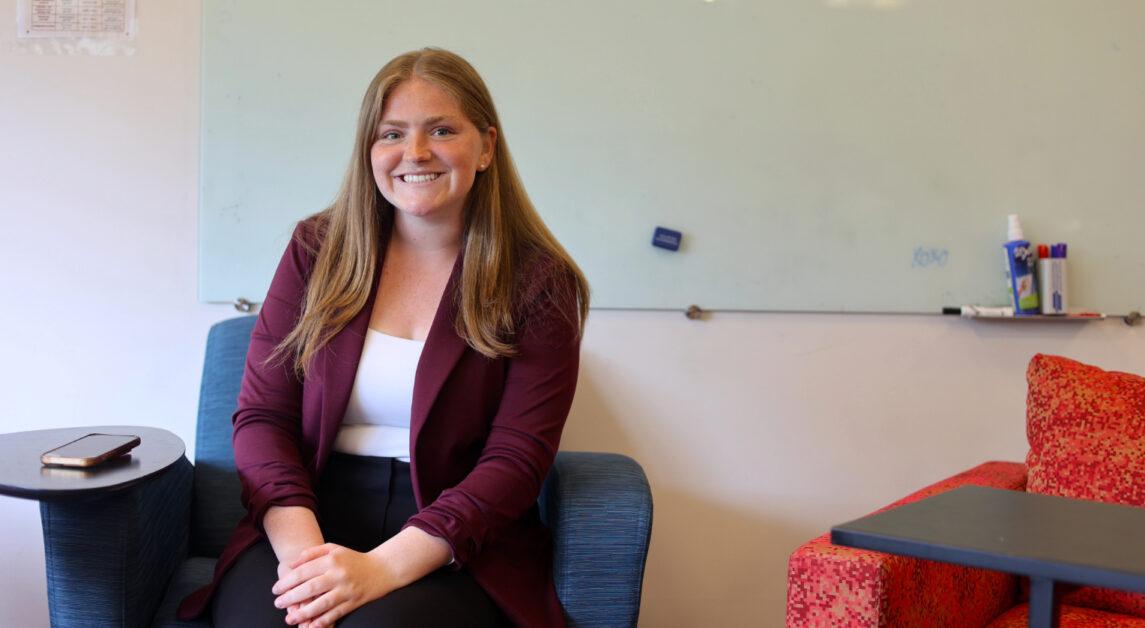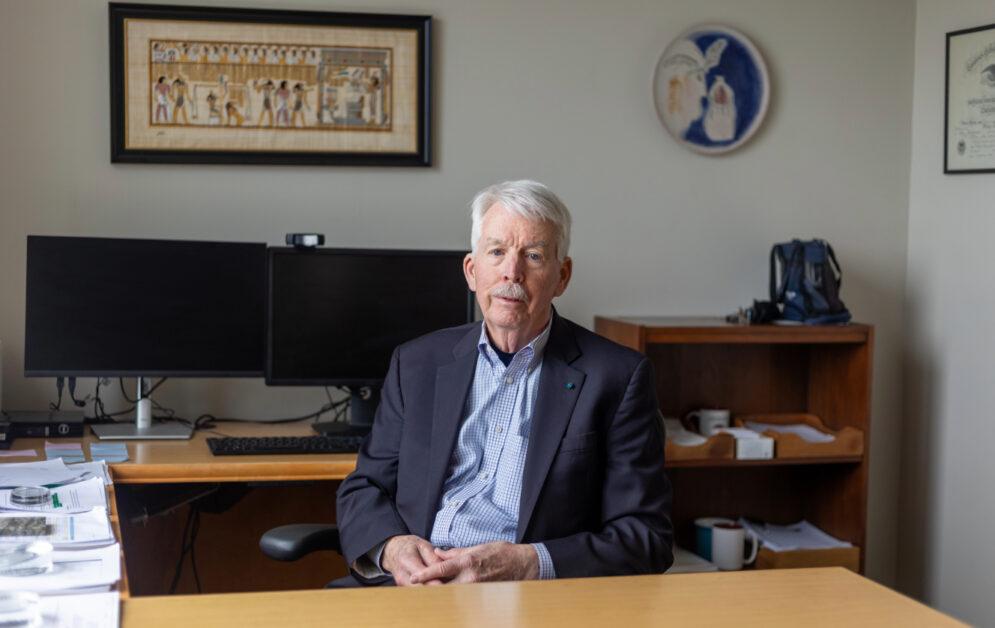In wood sculptor Ken Packie’s world, each project is an opportunity to assume a different identity.
“I get lost in it,” Packie said. “It puts you right in the moment. If I’m carving a fox, I’ll think about the foxes I see, or I’ll look at videos for reference and [try to understand] what the animal is thinking.”
For his most recent commission, Packie challenged himself to consider the daily experiences of a more difficult subject. His latest work, a 14 feet by 7 feet statue of the Holy Family—Jesus Christ, Mary, and Joseph—overlooks Commonwealth Ave. on Boston College’s Brighton Campus.
On commutes back and forth from BC during the days he was working on his carving, Packie said he listened to podcasts about the life of Jesus and his family, answering questions like, “What was the beginning of his life like? And what was their daily life like?” Packie said that reflections on the importance of the subject matter put him into the right headspace for his craft.
After COVID-19 sent the world into quarantine in March 2020, Packie was slammed with orders and requests for his sculptures—with people spending more time at home, many decided that they needed art to spruce up their decor, he said. One such customer was BC, which contacted Packie about a potential project.
Last November, Director of Landscape Planning and Services Regina Bellavia made the difficult decision to remove a 200-year-old tree which threatened the safety of pedestrians due to the way it was rotting. University President Rev. William P. Leahy, S.J., had seen a news article about Packie’s sculpture of a marathon runner near Heartbreak Hill and recommended him for the job, Packie said.
For 15 days over the course of five weeks, Packie transformed the old red oak tree into a lifelike rendering of the Holy Family. Creating art from a formerly living thing is not easy, Packie said. Ants had nestled in the back of the tree, and the trunk was rotten or hollow at some spots. At one point, he hit a rock which the tree had grown around, he said, but the sheer size of the tree still made it a worthy canvas for the sculpture.
For Packie, salvaging the remains of old trees is a way to honor nature in a world where the environment is often mistreated. Even before becoming a carver, Packie loved spending time in nature—whitewater rafting, climbing, mountain biking, and snowboarding. He often refuses to take on jobs involving a tree that doesn’t need to be taken down, he said.
“This is a living thing,” Packie said. “It’s 100 years old or older, and it’s nice that it’s preserved. It’s got a new form.”
Packie said that sculpting a very realistic human form out of a tree trunk was his most difficult challenge to date, from the crinkles near the eyes to the details on the fingers. According to Packie, depicting the clothing was also tricky, as the robes needed to drape off the arms and shoulders, while still maintaining the appearance that a human body exists under the heavy clothing.
According to Packie, Leahy was very helpful with the design of the sculpture, offering suggestions on the gesture of the hands and the tilt of the head.
“Father Leahy has a wonderful eye for form,” Packie said.
Aside from the technical aspects of human form, the significance of the subject matter weighed heavily on Packie. He was baptized in the Catholic Church and attended church regularly as a child, but he said he doesn’t anymore. Still, the significance of his religious experiences prompted reflection during his work on the Holy Family.
“I started thinking about that aspect of it too,” he said. “What does this mean to people? But you know, what does it mean to me? Where do I stand with this?”
Jason Emmons, a fellow professional wood carver, was especially impressed by Packie’s finished product.
“It’s stunning,” Emmons said. “He really knocked it out of the park, and he should be getting all the praise that he’s been getting from that piece and then some.”
Emmons travels the country with Packie as part of the Bear Hollow Wood Carvers, and has known him for around 15 years, all throughout Packie’s remarkable entry into carving, he said.
Packie’s journey to wood sculpting resulted from a rather unexpected career change. Born in New Jersey, Packie originally worked as a telecommunications technician. He and his family moved to the Berkshires for a new job, testing and tuning up high-speed networks. The company required him to be constantly on call, and Packie said that the lifestyle left him feeling burnt out.
In 2006, Packie attended a home show, which is a convention for home decor and furnishings, that featured a live wood sculptor. Whereas other sculptors render wood bears in a cartoonish fashion, what Packie calls “square bears,” this particular sculptor employed a very realistic style. Packie said that this lifelike bear interested him much more than the other wood-sculpted bears he had seen around New England.
“I thought that was the limitation of the tool, but it was actually the limitation of the operator,” Packie said.
Having never touched a chainsaw before, Packie took a class on wood sculpting and was hooked. After a year and a half of carving as an amateur, Packie attended a big gathering of carvers located in Pennsylvania. Sizing himself up against professional carvers, Packie says he realized that he could make a living on wood sculpting.
He set up outside a local country store near his home in the Berkshires and quickly became swamped with enough orders to leave his old job in telecommunications. He said his family encouraged him to make the uncertain change, even if it meant cutting back on vacations and Packie needing to work every day. With the help of local loggers and other benefactors, Packie took the leap of faith.
“They’re all supportive of me and so much help in town,” Packie said. “I say it as a joke, but seriously, it takes a village to raise a carver.”
In the beginning, Packie was surprised by the physical aspect of wood sculpting.
“I wasn’t really concerned about the physicality of the job, but it kicked my butt,” Packie said. “Holding the chainsaw all day, and standing up logs, and bending over and picking up trunks—the hard part was my body adapting to the physical work.”
Persevering through physical strain and uncertainty, Packie’s success reminded him of an event from his adolescence.
Before senior year of high school, Packie attended a week-long career testing examination. He tested off the charts for spatial mathematics, and someone recommended architecture as a possible career, he said. He took a drafting class, but he hated the straight lines and structure of traditional architecture. Now, Packie credits his natural skills to his aptitude for math.
“When I started carving, I had the confidence that I could see in 3D and that my mind worked the right way,” Packie said.
According to Emmons, Packie also brings a keen attention to detail and inexhaustible energy for carving.
“He brings a lot of passion to what he does,” Emmons said. “With that passion comes a lot of energy, and it’s contagious. He’s definitely the kind of guy you want to have around and be friends with.”
Packie says that the BC staff and grounds crew were incredibly helpful for his work. University carpenters built Packie a platform to stand on, and people stopped by to bring him water on hot days.
“I felt like I was a rock star up there, and that made my life so easy,” Packie said.
Next up on Packie’s to-do list has nothing to do with wood carving. By winter, Packie hopes to have completed his long-time dream of building his own log cabin. In fact, he’s stepped away from carving until he can get the logs up and the windows and roof set in place.
“It was a long time coming, but I’m pretty excited,” Packie said.
Featured image courtesy of Ken Packie
Graphic by Olivia Charbonneau / Heights Editor

